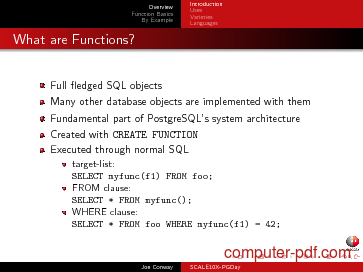

There is no need to clean or sanitize strings passed to the query builder as query bindings. The Laravel query builder uses PDO parameter binding to protect your application against SQL injection attacks. It can be used to perform most database operations in your application and works perfectly with all of Laravel's supported database systems.
#Having postgresql example how to
In this tutorial, you have learned how to use PostgreSQL WHERE clause in the SELECT statement to filter rows based on a specified condition.Laravel's database query builder provides a convenient, fluent interface to creating and running database queries. Note that you can use the != operator and operator interchangeably because they are equivalent.
#Having postgresql example code
Last_name 'Motley' Code language: SQL (Structured Query Language) ( sql ) This example finds customers whose first names start with Bra and last names are not Motley: SELECT 7) Using the WHERE clause with the not equal operator () example In this example, we used the LENGTH() function gets the number of characters of an input string. Name_length Code language: SQL (Structured Query Language) ( sql ) SELECTįirst_name LIKE 'A%' AND LENGTH(first_name) BETWEEN 3 AND 5 ORDER BY The BETWEEN operator returns true if a value is in a range of values. The following example finds customers whose first names start with the letter A and contains 3 to 5 characters by using the BETWEEN operator. 6) Using the WHERE clause with the BETWEEN operator example The 'Ann%' pattern matches any string that starts with 'Ann'. The % is called a wildcard that matches any string. The following example returns all customers whose first names start with the string Ann: SELECTįirst_name LIKE 'Ann%' Code language: SQL (Structured Query Language) ( sql ) To find a string that matches a specified pattern, you use the LIKE operator. If you want to match a string with any string in a list, you can use the IN operator.įor example, the following statement returns customers whose first name is Ann, or Anne, or Annie: SELECTįirst_name IN ( 'Ann', 'Anne', 'Annie') Code language: SQL (Structured Query Language) ( sql ) 5) Using the WHERE clause with the LIKE operator example This example finds the customers whose last name is Rodriguez or first name is Adam by using the OR operator: SELECTįirst_name = 'Adam' Code language: SQL (Structured Query Language) ( sql ) 4) Using WHERE clause with the IN operator example Last_name = 'Rice' Code language: SQL (Structured Query Language) ( sql ) 3) Using the WHERE clause with the OR operator example The following example finds customers whose first name and last name are Jamie and rice by using the AND logical operator to combine two Boolean expressions: SELECT The following statement uses the WHERE clause customers whose first names are Jamie: SELECTįirst_name = 'Jamie' Code language: SQL (Structured Query Language) ( sql ) 2) Using WHERE clause with the AND operator example 1) Using WHERE clause with the equal ( =) operator example


We will use the customer table from the sample database for demonstration. Let’s practice with some examples of using the WHERE clause. Return true if a value is between a range of values Return true if a value matches any value in a list To form the condition in the WHERE clause, you use comparison and logical operators: Operator
#Having postgresql example update
If you use column aliases in the SELECT clause, you cannot use them in the WHERE clause.īesides the SELECT statement, you can use the WHERE clause in the UPDATE and DELETE statement to specify rows to be updated or deleted. PostgreSQL evaluates the WHERE clause after the FROM clause and before the SELECT and ORDER BY clause: In other words, only rows that cause the condition evaluates to true will be included in the result set. The query returns only rows that satisfy the condition in the WHERE clause. It can be a boolean expression or a combination of boolean expressions using the AND and OR operators. The condition must evaluate to true, false, or unknown. The WHERE clause uses the condition to filter the rows returned from the SELECT clause. The WHERE clause appears right after the FROM clause of the SELECT statement. ORDER BY sort_expression Code language: SQL (Structured Query Language) ( sql ) The syntax of the PostgreSQL WHERE clause is as follows: SELECT select_list To select rows that satisfy a specified condition, you use a WHERE clause.

The SELECT statement returns all rows from one or more columns in a table. Summary: in this tutorial, you will learn how to use PostgreSQL WHERE clause to filter rows returned by a SELECT statement.


 0 kommentar(er)
0 kommentar(er)
